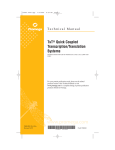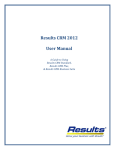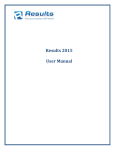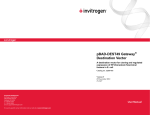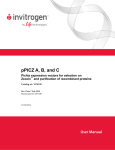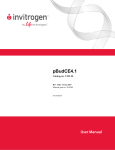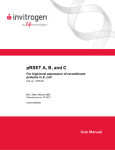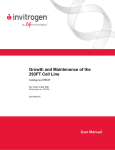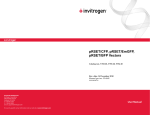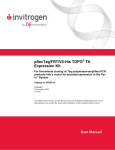Download pcDNA - Molecular Info
Transcript
pcDNA™4/HisMax A, B, and C Catalog no. V864-20 Rev. Date: 31 October 2010 Manual part no. 25-0258 MAN0000096 Corporate Headquarters Invitrogen Corporation 1600 Faraday Avenue Carlsbad, CA 92008 T: 1 760 603 7200 F: 1 760 602 6500 E: [email protected] For country-specific contact information visit our web site at www.invitrogen.com User Manual ii Table of Contents Kit Contents and Storage..................................................................................................................................... iv Introduction ................................................................................................................... 1 Product Overview ..................................................................................................................................................1 Methods ......................................................................................................................... 2 Cloning into pcDNA™4/HisMax A, B, and C ....................................................................................................2 Transfection and Analysis.....................................................................................................................................8 Creation of Stable Cell Lines...............................................................................................................................10 Appendix...................................................................................................................... 13 pcDNA™4/HisMax Vector..................................................................................................................................13 pcDNA™4/HisMax/lacZ.....................................................................................................................................15 Zeocin™ ..................................................................................................................................................................16 Recipes ...................................................................................................................................................................18 Accessory Products ..............................................................................................................................................19 Technical Support.................................................................................................................................................20 Purchaser Notification .........................................................................................................................................21 References..............................................................................................................................................................22 iii Kit Contents and Storage Shipping and Storage pcDNA™4/HisMax vectors are shipped on wet ice. Upon receipt, store vectors at -20°C. Kit Contents All vectors are supplied as detailed below. Store the vectors at –20°C. Vector iv Composition Amount pcDNA 4/HisMax A, B, and C 40 L of 0.5 g/μL vector in 10 mM TrisHCl, 1 mM EDTA, pH 8.0 20 g pcDNA™4/HisMax/lacZ 40 L of 0.5 g/μL vector in 10 mM TrisHCl, 1 mM EDTA, pH 8.0 20 g ™ Introduction Product Overview Description of the System pcDNA™4/HisMax A, B, and C are 5.3 kb vectors derived from pcDNA™4/His and designed for overproduction of recombinant proteins in mammalian cell lines. Features of the vectors allow purification and detection of expressed proteins (see pages 13-14 for more information). High-level stable and transient expression can be carried out in most mammalian cells. The vectors contain the following elements: Human cytomegalovirus immediate-early (CMV) promoter for high-level expression in a wide range of mammalian cells. QBI SP163 translational enhancer for increased levels of recombinant protein expression (Stein et al., 1998) (see page 3 for more information). Three reading frames to facilitate in-frame cloning with an N-terminal peptide encoding the Xpress™ epitope and a polyhistidine metal-binding tag. Zeocin™ resistance gene for selection of stable cell lines (Mulsant et al., 1988) (see page 16 for more information). Episomal replication in cell lines that are latently infected with SV40 or that express the SV40 large T antigen (e.g. COS-1, COS-7). The control plasmid, pcDNA™4/HisMax /lacZ, is included for use as a positive control for transfection, expression, and detection in the cell line of choice. Experimental Outline Use the following outline to clone and express your gene of interest in pcDNA™4/HisMax. Consult the multiple cloning sites described on pages 4-6 to determine which vector (A, B, or C) should be used to clone your gene in frame with the Nterminal Xpress™ epitope and the polyhistidine tag. 1. Ligate your insert into the appropriate vector and transform into E. coli. Select transformants on 50 to 100 μg/mL ampicillin or 25-50 g/mL Zeocin™. 2. Analyze your transformants for the presence of insert by restriction digestion. 3. Select a transformant with the correct restriction pattern and use sequencing to confirm that your gene is cloned in frame with the N-terminal peptide. 4. Transfect your construct into the cell line of choice using your own method of transfection. Generate a stable cell line, if desired. 5. Test for expression of your recombinant gene by western blot analysis or functional assay. For the antibody to the Xpress™ epitope, see page 19. To purify your recombinant protein, you may use metal-chelating resin such as ProBond™. ProBond™ resin is available separately (see page 19 for ordering information). 1 Methods Cloning into pcDNA™4/HisMax A, B, and C General Molecular Biology Techniques For help with DNA ligations, E. coli transformations, restriction enzyme analysis, purification of single-stranded DNA, DNA sequencing, and DNA biochemistry, refer to Molecular Cloning: A Laboratory Manual (Sambrook et al., 1989) or Current Protocols in Molecular Biology (Ausubel et al., 1994). E. coli Host Many E. coli strains are suitable for the propagation of this vector. We recommend that you propagate vectors containing inserts in E. coli strains that are recombination deficient (recA) and endonuclease A deficient (endA). For your convenience, TOP10F´ is available as chemically competent or electrocompetent cells from Invitrogen (see page 19). Transformation Method You may use any method of your choice for transformation. Chemical transformation is the most convenient for most researchers. Electroporation is the most efficient and the method of choice for large plasmids. Maintaining pcDNA™4/HisMax To propagate and maintain the pcDNA™4/HisMax vectors, use a small amount of the supplied 0.5 g/μL stock solution in TE, pH 8.0 to transform a recA, endA E. coli strain like TOP10F´, DH5, JM109, or equivalent. Select transformants on LB plates containing 50 to 100 g/mL ampicillin or 25 to 50 g/mL Zeocin™ in Low Salt LB. Be sure to prepare a glycerol stock of each plasmid for long-term storage (see page 7 for protocol). Continued on next page 2 Cloning into pcDNA™4/HisMax A, B, and C, Continued QBI SP163 Translational Enhancer The QBI SP163 element is a 163 nucleotide splice variant derived from the 5´ untranslated region (UTR) of the mouse vascular endothelial growth factor (VEGF) gene (Stein et al., 1998). The splice variant is composed of a 31 nucleotide fragment containing the 5´ cap sequence of the VEGF gene fused to a 132 nucleotide fragment of the 5´ UTR immediately preceding the translational start site of the VEGF gene. Refer to the diagrams on pages 4-6 for the sequence of the QBI SP163 element. The QBI SP163 element functions as a strong translational enhancer and acts to increase recombinant protein production when placed directly upstream of the ATG initiation codon of the gene of interest. The increase in protein expression is thought to occur through ribosome recruitment and a cap-independent translation mechanism. (Stein et al., 1998). In general, expression levels of recombinant protein from pcDNA™4/HisMax are 2-5 fold greater than the levels obtained with the pcDNA™4/His expression vector. The amount of recombinant protein expressed will vary depending on the nature of the gene of interest. The pcDNA™4/HisMax vectors are fusion vectors. To ensure proper expression of your recombinant protein, you must clone your gene in frame with the ATG at base pairs 1080–1082. This creates a fusion with the N-terminal polyhistidine tag, Xpress™ epitope, and the enterokinase cleavage site. The vector is supplied with the multiple cloning site in three reading frames relative to the N-terminal peptide to facilitate cloning. See pages 4-6 to develop a cloning strategy. If you wish to clone your gene as close as possible to the enterokinase cleavage site, follow the guidelines below: Digest pcDNA™4/HisMax A, B, or C with Kpn I. Create blunt ends with T4 DNA polymerase and dNTPs. Clone your blunt-ended insert in frame with the lysine codon (AAG) of the enterokinase recognition site. If you wish to separate your protein of interest from the N-terminal peptide tag, you may use any suitable enterokinase including EnterokinaseMax™ from Invitrogen (see page 19). Following enterokinase cleavage, no vector-encoded amino acid residues will be present in your protein. Continued on next page 3 Cloning into pcDNA™4/HisMax A, B, and C, Continued Multiple Cloning Site of Version A Below is the multiple cloning site for pcDNA™4/HisMax A. Restriction sites are labeled to indicate the cleavage site. The boxed nucleotides indicate the variable region. Note that there is a stop codon within the Xba I site. The multiple cloning site has been confirmed by sequencing and functional testing. The vector sequence of pcDNA™4/HisMax A is available for downloading from our website (www.invitrogen.com) or from Technical Support (see page 20). T7 promoter/priming site 821 CTGGCTAACT AGAGAACCCA CTGCTTACTG GCTTATCGAA ATTAATACGA CTCACTATAG 881 GGAGACCCAA GCTGGCTAGC GTTTAAACTT AAGCTTAGCG CAGAGGCTTG GGGCAGCCGA QBI SP163 translational enhancer 941 GCGGCAGCCA GGCCCCGGCC CGGGCCTCGG TTCCAGAAGG GAGAGGAGCC CGCCAAGGCG 1001 CGCAAGAGAG CGGGCTGCCT CGCAGTCCGA GCCGGAGAGG GAGCGCGAGC CGCGCCGGCC Polyhistidine Region 1061 CCGGACGGCC TCCGAAACC ATG GGG GGT TCT CAT CAT CAT CAT CAT CAT Met Gly Gly Ser His His His His His His Xpress Epitope 1110 GGT ATG GCT AGC ATG ACT GGT GGA CAG CAA ATG GGT CGG GAT CTG TAC Gly Met Ala Ser Met Thr Gly Gly Gln Gln Met Gly Arg Asp Leu Tyr Asp718 I Kpn I BamH I 1158 EcoR I Pst I GAC GAT GAC GAT AAG GTA CCT AGG ATC CAG TGT GGT GGA ATT CTG CAG Asp Asp Asp Asp Lys Val Pro Arg Ile Gln Cys Gly Gly Ile Leu Gln Enterokinase recognition site EcoR V 1206 BstX I* BstX I* EK cleavage site Not I Xho I Xba I Apa I ATA TCC AGC ACA GTG GCG GCC GCT CGA GTC TAG AGGGCCCGTT TAAACCCGCT Ile Ser Ser Thr Val Ala Ala Ala Arg Val *** BGH reverse priming site 1259 GATCAGCCTC GACTGTGCCT TCTAGTTGCC AGCCATCTGT TGTTTGCCCC TCCCCCGTGC Continued on next page 4 Cloning into pcDNA™4/HisMax A, B, and C, Continued Multiple Cloning Site of Version B Below is the multiple cloning site for pcDNA™4/HisMax B. Restriction sites are labeled to indicate the cleavage site. The boxed nucleotides indicate the variable region. The multiple cloning site has been confirmed by sequencing and functional testing. The vector sequence of pcDNA™4/HisMax B is available for downloading from our website (www.invitrogen.com) or from Technical Support (see page 20). T7 promoter/priming site 821 CTGGCTAACT AGAGAACCCA CTGCTTACTG GCTTATCGAA ATTAATACGA CTCACTATAG 881 GGAGACCCAA GCTGGCTAGC GTTTAAACTT AAGCTTAGCG CAGAGGCTTG GGGCAGCCGA QBI SP163 translational enhancer 941 GCGGCAGCCA GGCCCCGGCC CGGGCCTCGG TTCCAGAAGG GAGAGGAGCC CGCCAAGGCG 1001 CGCAAGAGAG CGGGCTGCCT CGCAGTCCGA GCCGGAGAGG GAGCGCGAGC CGCGCCGGCC Polyhistidine Region 1061 CCGGACGGCC TCCGAAACC ATG GGG GGT TCT CAT CAT CAT CAT CAT CAT Met Gly Gly Ser His His His His His His Xpress Epitope 1110 GGT ATG GCT AGC ATG ACT GGT GGA CAG CAA ATG GGT CGG GAT CTG TAC Gly Met Ala Ser Met Thr Gly Gly Gln Gln Met Gly Arg Asp Leu Tyr Asp718 I Kpn I 1158 BstX I* EcoR I Pst I GAC GAT GAC GAT AAG GTA CCT AAG GAT CCA GTG TGG TGG AAT TCT GCA Asp Asp Asp Asp Lys Val Pro Lys Asp Pro Val Trp Trp Asn Ser Ala Enterokinase recognition site EcoR V 1206 BamH I BstX I* EK cleavage site Not I Xho I Xba I Apa I GAT ATC CAG CAC AGT GGC GGC CGC TCG AGT CTA GAG GGC CCG TTT AAA Asp Ile Gln His Ser Gly Gly Arg Ser Ser Leu Glu Gly Pro Phe Lys BGH reverse priming site 1254 CCC GCT GAT CAG CCT CGA CTG TGC CTT CTA GTT GCC AGC CAT CTG TTG Pro Ala Asp Gln Pro Arg Leu Cys Leu Leu Val Ala Ser His Leu Leu 1302 TTT GCC CCT CCC CCG TGC CTT CCT TGA CCCTGGAAGG TGCCACTCCC Phe Ala Pro Pro Pro Cys Leu Pro *** Continued on next page 5 Cloning into pcDNA™4/HisMax A, B, and C, Continued Multiple Cloning Site of Version C Below is the multiple cloning site for pcDNA™4/HisMax C. Restriction sites are labeled to indicate the cleavage site. The boxed nucleotide indicates the variable region. The multiple cloning site has been confirmed by sequencing and functional testing. The vector sequence of pcDNA™4/HisMax C is available for downloading from our website (www.invitrogen.com) or from Technical Support (see page 20). T7 promoter/priming site 821 CTGGCTAACT AGAGAACCCA CTGCTTACTG GCTTATCGAA ATTAATACGA CTCACTATAG 881 GGAGACCCAA GCTGGCTAGC GTTTAAACTT AAGCTTAGCG CAGAGGCTTG GGGCAGCCGA 941 GCGGCAGCCA GGCCCCGGCC CGGGCCTCGG TTCCAGAAGG GAGAGGAGCC CGCCAAGGCG 1001 CGCAAGAGAG CGGGCTGCCT CGCAGTCCGA GCCGGAGAGG GAGCGCGAGC CGCGCCGGCC QBI SP163 translational enhancer Polyhistidine Region 1061 CCGGACGGCC TCCGAAACC ATG GGG GGT TCT CAT CAT CAT CAT CAT CAT Met Gly Gly Ser His His His His His His Xpress Epitope 1110 GGT ATG GCT AGC ATG ACT GGT GGA CAG CAA ATG GGT CGG GAT CTG TAC Gly Met Ala Ser Met Thr Gly Gly Gln Gln Met Gly Arg Asp Leu Tyr Asp718 I Kpn I BamH I 1158 EcoR I Pst I GAC GAT GAC GAT AAG GTA CCA GGA TCC AGT GTG GTG GAA TTC TGC AGA Asp Asp Asp Asp Lys Val Pro Gly Ser Ser Val Val Glu Phe Cys Arg Enterokinase recognition site EcoR V 1206 BstX I* BstX I* EK cleavage site Not I Xho I Xba I Apa I TAT CCA GCA CAG TGG CGG CCG CTC GAG TCT AGA GGG CCC GTT TAA Tyr Pro Ala Gln Trp Arg Pro Leu Glu Ser Arg Gly Pro Val *** BGH reverse priming site 1251 6 ACCCGCTGAT CAGCCTCGAC TGTGCCTTCT AGTTGCCAGC CATCTGTTGT TTGCCCCTCC Cloning into pcDNA™4/HisMax A, B, and C, Continued E. coli Transformation MEND ION AT RECOM Important Preparing a Glycerol Stock Transform your ligation mixtures into a competent recA, endA E. coli strain (e.g. TOP10F´, DH5) and select on LB plates containing 50-100 μg/mL ampicillin or 25-50 g/mL Zeocin™ in Low Salt LB medium (see page 18). Select 10–20 clones and analyze for the presence and orientation of your insert. Any E. coli strain that contains the complete Tn5 transposable element (i.e. DH5F´IQ, SURE, SURE2) encodes the ble gene (bleomycin resistance gene). These strains will confer resistance to Zeocin™. For the most efficient selection, we recommend an E. coli strain that does not contain the Tn5 gene (i.e., TOP10, DH5, DH10, etc.). We recommend that you sequence your construct with the T7 Forward and BGH Reverse primers to confirm that your gene is fused in frame with the N-terminal polyhistidine tag and the Xpress™ epitope. For ordering primers, see page 19. Note that if you use the T7 Forward primer to sequence your insert, approximately 300 bp of sequence encoding the QBI SP163 element and the N-terminal tag will precede the sequence of your insert. Once you have identified the correct clone, be sure to purify the colony and make a glycerol stock for long-term storage. It is also a good idea to keep a DNA stock of your plasmid at –20°C in case you lose the glycerol stock. 1. Streak the original colony out on an LB plate containing 50 g/mL ampicillin or 25 g/mL Zeocin™ in Low Salt LB (see page 18). Incubate the plate at 37°C overnight. 2. Isolate a single colony and inoculate into 1–2 mL of LB containing 50 g/mL ampicillin or 25 g/mL Zeocin™. 3. Grow the culture to mid-log phase (OD600 = 0.5–0.7). 4. Mix 0.85 mL of culture with 0.15 mL of sterile glycerol and transfer to a cryovial. 5. Store at –80°C. 7 Transfection and Analysis Plasmid Preparation Plasmid DNA for transfection into eukaryotic cells must be very clean and free from phenol and sodium chloride. Contaminants will kill the cells, and salt will interfere with lipids, decreasing transfection efficiency. We recommend isolating plasmid DNA using the PureLink™ HiPure Miniprep Kit or the PureLink™ HiPure Midiprep Kit (see page 19 for ordering information). Method of Transfection For established cell lines (e.g. HeLa), consult original references or the supplier of your cell line for the optimal method of transfection. We recommend that you follow exactly the protocol for your cell line. Pay particular attention to medium requirements, when to pass the cells, and at what dilution to split the cells. Further information is provided in Current Protocols in Molecular Biology (Ausubel et al., 1994). Methods for transfection include calcium phosphate (Chen and Okayama, 1987; Wigler et al., 1977), lipid-mediated (Felgner et al., 1989; Felgner and Ringold, 1989) and electroporation (Chu et al., 1987; Shigekawa and Dower, 1988). Invitrogen offers the Lipofectamine™ 2000 Reagent for mammalian transfection. Refer to our website (www.invitrogen.com) or call Technical Support (see page 20) for more information. Positive Control pcDNA™4/HisMax/lacZ is provided as a positive control vector for mammalian cell transfection and expression (see page 15) and may be used to optimize transfection conditions for your cell line. The gene encoding -galactosidase is expressed in mammalian cells under the control of the CMV promoter. A successful transfection will result in -galactosidase expression that can be easily assayed (see below). Assay for -galactosidase Activity You may assay for -galactosidase expression by activity assay using cell-free lysates (Miller, 1972) or by staining the cells for activity. Invitrogen offers the -Gal Assay Kit and the -Gal Staining Kit for fast and easy detection of -galactosidase expression (see page 19). Continued on next page 8 Transfection and Analysis, Continued Detecting Fusion Proteins The Anti-Xpress™ antibodies and the Anti-HisG antibodies are available from Invitrogen to detect expression of your fusion protein from pcDNA™4/HisMax (see page 19). To detect the fusion protein by western blot, you need to prepare a cell lysate from transfected cells. We recommend that you perform a time course to optimize expression of the fusion protein (e.g., 24, 48, 72 hours, etc. after transfection). To lyse cells: 1. Wash cell monolayers (~106 cells) once with phosphate-buffered saline (PBS). 2. Scrape cells into 1 mL PBS and pellet the cells at 1,500 × g for 5 minutes. 3. Resuspend in 50 L Cell Lysis Buffer (see page 18). Other cell lysis buffers are suitable. 4. Incubate cell suspension at 37°C for 10 minutes to lyse the cells. Note: You may prefer to lyse the cells at room temperature or on ice if degradation of your protein is a potential problem. 5. Centrifuge the cell lysate at 10,000 × g for 10 minutes to pellet nuclei and transfer the supernatant to a fresh tube. Assay the lysate for protein concentration. Note: Do not use protein assays utilizing Coomassie® Blue or other dyes. NP40 interferes with the binding of the dye with the protein. 6. Add SDS-PAGE sample buffer to a final concentration of 1X and boil the sample for 5 minutes. 7. Load 20 g of lysate onto an SDS-PAGE gel and electrophorese. Use the appropriate percentage of acrylamide to resolve your fusion protein. The N-terminal peptide containing the Xpress™ epitope and the polyhistidine tag will add approximately 3.4 kDa to the size of your protein. Note that the QBI SP163 element is not translated. Purification You will need 5 × 106 to 1 × 107 transfected cells for purification of your protein on a 2 mL ProBond™ column (or other metal-chelating column). Refer to the manufacturer's instructions before attempting to purify your fusion protein. To prepare cells for lysis, refer to the protocol on page 12. 9 Creation of Stable Cell Lines Introduction pcDNA™4/HisMax vectors contain the Zeocin™ resistance gene for selection of stable cell lines using Zeocin™. We recommend that you test the sensitivity of your mammalian host cell to Zeocin™ as natural resistance varies among cell lines. General information and guidelines are provided below for your convenience. For more information about Zeocin™, refer to page 16. Effect of Zeocin™ on Sensitive and Resistant Cells The method of killing with Zeocin™ is quite different from neomycin and hygromycin. Cells do not round up and detach from the plate. Sensitive cells may exhibit the following morphological changes upon exposure to Zeocin™: Vast increase in size (similar to the effects of cytomegalovirus infecting permissive cells) Abnormal cell shape Presence of large empty vesicles in the cytoplasm (breakdown of the endoplasmic reticulum and golgi apparatus, or other scaffolding proteins) Breakdown of plasma and nuclear membrane (appearance of many holes in these membranes) Eventually, these "cells" will completely break down and only cellular debris will remain. Zeocin™-resistant cells should continue to divide at regular intervals to form distinct colonies. There should not be any distinct morphological changes in Zeocin™-resistant cells when compared to cells not under selection with Zeocin™. Selection in Mammalian Cell Lines To generate a stable cell line expressing your protein, you need to determine the minimum concentration of Zeocin™ required to kill your untransfected host cell line. In general, concentrations ranging from 50 to 1,000 g/mL Zeocin™ are sufficient to kill the untransfected host cell line, with the average being 250 to 400 g/mL. Test a range of concentrations (see below) to ensure that you determine the minimum concentration necessary for your cell line. 1. Seed cells (20–25% confluent) for each time point and allow cells to adhere overnight. 2. The next day, substitute culture medium with medium containing varying concentrations of Zeocin™ (e.g., 0, 50, 100, 200, 400, 600, 800, and 1,000 g/mL). 3. Replenish the selective medium every 3–4 days, and observe the percentage of surviving cells. 4. Count the number of viable cells at regular intervals to determine the appropriate concentration of Zeocin™ that prevents growth. Select the concentration that kills the majority of the cells in the desired number of days (4–10 days). Continued on next page 10 Creation of Stable Cell Lines, Continued Possible Sites for Linearization Enzyme To obtain stable transfectants, you may choose to linearize your vector before transfection. While linearizing your vector may not improve the efficiency of transfection, it increases the chances that the vector does not integrate in a way that disrupts the gene of interest. The table below lists unique sites that may be used to linearize your construct prior to transfection. Other restriction sites are possible. Note that for the enzymes listed below, the cleavage site is indicated for versions A, B, and C of pcDNA™4/HisMax. Be sure that your insert does not contain the restriction enzyme site you wish to use to linearize your vector. Restriction Site (bp) (A,B,C) Location Supplier Bgl II 12 Upstream of CMV promoter Many Mfe I 161 Upstream of CMV promoter New England Biolabs Nru I 208 Upstream of CMV promoter Many Bst1107 I 3063 (A), 3064 (B), 3062 (C) End of SV40 poly A AGS*, Fermentas, Takara, Boehringer-Mannhiem Eam1105 I 4335 (A), 4336 (B), 4334 (C) Ampicillin gene AGS*, Fermentas, Takara Fsp I 4557 (A), 4558 (B), 4556 (C) Ampicillin gene Many Pvu I 4705 (A), 4706 (B), 4704 (C) Ampicillin gene Many Sca I 4815 (A), 4816 (B), 4814 (C) Ampicillin gene Many Ssp I 5139 (A), 5140 (B), 5138 (C) Backbone Many *Angewandte Gentechnologie Systeme Selection Tip Some cells may be more resistant to Zeocin™ than others. If cells are dividing rapidly, Zeocin™ may not be effective at low concentrations. To overcome this resistance, we recommend that you place the cells at 4°C for 2 hours after plating (be sure to buffer the medium with HEPES). Then return the cells to 37°C. This stops the cell division process for a short time and allows Zeocin™ to act. Continued on next page 11 Creation of Stable Cell Lines, Continued Selecting Stable Integrants Once the appropriate Zeocin™ concentration is determined, you can generate a stable cell line with your construct. 1. Transfect your cells using the appropriate protocol for your cell line. Include a sample of untransfected cells as a negative control. 2. After transfection, wash the cells once with 1X PBS and add fresh medium to the cells. 3. 48 hours after transfection, split the cells into fresh medium containing Zeocin™ at the appropriate concentration for your cell line. Split the cells such that they are no more than 25% confluent. 4. Replenish selective medium every 3–4 days until Zeocin™-resistant colonies are detected. 5. Pick and expand colonies in 96- or 48-well plates. Grow cells to near confluence before expanding to larger wells or plates. Preparing Cells for Use the procedure below to prepare cells for lysis prior to purification of your protein on ProBond™. You will need 5 × 106 to 1 × 107 cells for purification of Lysis your protein on a 2 mL ProBond™ column (see ProBond™ Purification System manual). Lysis of Cells 12 1. Seed cells in five T-75 flasks or 2 to 3 T-175 flasks. 2. Grow the cells in selective medium until they are 80-90% confluent. 3. Harvest the cells by treating with trypsin-EDTA for 2 to 5 minutes or by scraping the cells in PBS. 4. Inactivate the trypsin by diluting with fresh medium (if necessary) and transfer the cells to a sterile microcentrifuge tube. 5. Centrifuge the cells at 240 × g for 5 minutes. Resuspend the cell pellet in PBS. 6. Centrifuge the cells at 240 × g for 5 minutes. Remove PBS. You may lyse the cells immediately or freeze in liquid nitrogen and store at –80°C until needed. If you are using ProBond™ resin, refer to the ProBond™ Purification System manual for details about sample preparation for chromatography. If you are using other metal-chelating resin, refer to the manufacturer's instruction for recommendations on sample preparation. Appendix pcDNA™4/HisMax Vector The figure below summarizes the features of the pcDNA™4/HisMax vectors. The Map of ™ pcDNA 4/HisMax sequences for pcDNA™4/HisMax A, B, and C are available for downloading from T7 SP163 Xpress EK Recognition Epitope Site ATG 6xHis V CM P BGH pA f1 Asp718 I Kpn I BamH I BstX I EcoR I Pst I EcoR V BstX I Not I Xho I Xba I* Apa I our website (www.invitrogen.com) or from Technical Support (see page 20). or i ri 40 o SV pU Co CMV promoter: bases 232-819 T7 promoter/priming site: bases 863-882 QBI SP163 translational enhancer: bases 917-1079 ATG initiation codon: bases 1080-1082 Polyhistidine tag: bases 1092-1109 Xpress epitope: bases 1149-1172 Enterokinase recognition site: bases 1158-1172 Multiple cloning site: bases 1172-1245 BGH reverse priming site: bases 1265-1282 BGH polyadenylation sequence: bases 1268-1495 f1 origin: bases 1541-1969 SV40 promoter and origin: bases 1996-2305 EM-7 promoter: bases 2353-2408 Zeocin resistance gene: bases 2427-2801 SV40 polyadenylation sequence: bases 2931-3061 pUC origin: bases 3444-4117 Ampicillin resistance gene: bases 4262-5122 in Comments for pcDNA4/HisMax A: 5258 nucleotides ri EM-7 n 5.3 kb Ze oc A m p i cil li pcDNA4/HisMax A, B, C * There is a stop codon following the Xba I site in version A. SV4 0 pA Continued on next page 13 pcDNA™4/HisMax Vector, Continued Features of pcDNA™4/HisMax pcDNA™4/HisMax A (5258 bp), pcDNA™4/HisMax B (5259 bp), and pcDNA™4/HisMax C (5257 bp) contain the following elements. All features have been functionally tested. Feature Benefit Human cytomegalovirus (CMV) Permits efficient, high-level expression of your immediate-early recombinant protein (Andersson et al., 1989; Boshart et al., promoter/enhancer 1985; Nelson et al., 1987). 14 T7 promoter/priming site Allows for in vitro transcription in the sense orientation and sequencing through the insert. QBI SP163 translational enhancer Increases expression of your recombinant protein via a cap-independent translation mechanism (Stein et al., 1998). N-terminal polyhistidine tag Permits purification of your recombinant protein on metalchelating resin such as ProBond™. Xpress™ epitope tag Allow detection of your recombinant protein with the Anti-Xpress™ Antibody. Enterokinase cleavage site Allows removal of the N-terminal tag from your recombinant protein using an enterokinase such as EnterokinaseMax™. Multiple cloning site in three reading frames Allows insertion of your gene and facilitates cloning in frame with the Xpress™ epitope and N-terminal polyhistidine tag. BGH reverse priming site Permits sequencing through the insert. Bovine growth hormone (BGH) polyadenylation signal Efficient transcription termination and polyadenylation of mRNA (Goodwin and Rottman, 1992). f1 origin Allows rescue of single-stranded DNA. SV40 early promoter and origin Allows efficient, high-level expression of the Zeocin™ resistance gene in mammalian cells and episomal replication in cells expressing the SV40 large T antigen. EM-7 promoter Synthetic promoter based on the bacteriophage T7 promoter for expression of the Zeocin™ resistance gene in E. coli. Zeocin™ resistance gene Selection of transformants in E. coli and stable transfectants in mammalian cells (Drocourt et al., 1990; Mulsant et al., 1988). SV40 polyadenylation signal Efficient transcription termination and polyadenylation of mRNA. pUC origin High-copy number replication and growth in E. coli. Ampicillin resistance gene (-lactamase) Selection of transformants in E. coli. pcDNA™4/HisMax/lacZ Map of Control Vector The figure below summarizes the features of the pcDNA™4/HisMax/lacZ vector. The vector sequence for pcDNA™4/HisMax/lacZ is available for downloading from our website (www.invitrogen.com) or from Technical Support (see page 20). T7 SP163 ATG 6xHis Xpress Epitope V CM P BGH pA f1 or i in C or i Ze oc n 8.3 kb EM-7 pcDNA4/ HisMax/lacZ pU lacZ ri 40 o SV A m p i ci l l i Comments for pcDNA4/HisMax/lacZ: 8321 nucleotides EK Recognition Site EcoR I Pst I Not I Xho I Xba I Apa I pcDNA™4/HisMax/lacZ is a 8321 bp control vector containing the gene for -galactosidase. This vector was constructed by ligating a 3.1 kb Kpn I-EcoR I fragment containing the lacZ gene into the Kpn I-EcoR I site of pcDNA™4/HisMax. Asp718 I Kpn I Description S V 4 0 pA CMV promoter: bases 232-819 T7 promoter/priming site: bases 863-882 QBI SP163 translational enhancer: bases 917-1079 ATG initiation codon: bases 1080-1082 Polyhistidine tag: bases 1092-1109 Xpress epitope: bases 1149-1172 Enterokinase recognition site: bases 1158-1172 LacZ ORF: bases 1197-4247 BGH reverse priming site: bases 4328-4345 BGH polyadenylation sequence: bases 4331-4558 f1 origin: bases 4604-5032 SV40 promoter and origin: bases 5059-5368 EM-7 promoter: bases 5416-5471 Zeocin resistance gene: bases 5490-5864 SV40 polyadenylation sequence: bases 5994-6124 pUC origin: bases 6507-7180 Ampicillin resistance gene: bases 7325-8185 15 Zeocin™ Introduction The pcDNA™4/HisMax vectors contain the Zeocin™ resistance gene for selection of stable cell lines using Zeocin™. We recommend that you test the sensitivity of your mammalian host cell to Zeocin™ as natural resistance varies among cell lines. General information and guidelines are provided in this section for your convenience. Zeocin™ Zeocin™ is a member of the bleomycin/phleomycin family of antibiotics isolated from Streptomyces. Antibiotics in this family are broad spectrum antibiotics that act as strong anti-bacterial and anti-tumor drugs. They show strong toxicity against bacteria, fungi (including yeast), plants, and mammalian cells (Baron et al., 1992; Drocourt et al., 1990; Mulsant et al., 1988; Perez et al., 1989). The Zeocin™ resistance protein has been isolated and characterized (Calmels et al., 1991; Drocourt et al., 1990). This protein, the product of the Sh ble gene (Streptoalloteichus hindustanus bleomycin gene), is a 13.7 kDa protein that binds Zeocin™ and inhibits its DNA strand cleavage activity. Expression of this protein in eukaryotic and prokaryotic hosts confers resistance to Zeocin™. Molecular Weight, Formula and Structure The formula for Zeocin™ is C55H86O21N20S2Cu-HCl and the molecular weight is 1,527.5 daltons. Zeocin™ is an HCl salt. The diagram below shows the structure of Zeocin™. CONH2 H H2 N N H O H N CH3 HO N Cu NH O N H N N H N O O N O O ++ H2N H N CH3 HO R S N S CH3 H OH O O CH3 R = HN NH2 N NH NH2 OH H2N O O HO O HO OH OH O Continued on next page 16 Zeocin™, Continued Applications of Zeocin™ Zeocin™ is used for selection in mammalian cells (Mulsant et al., 1988); plants (Perez et al., 1989); yeast (Baron et al., 1992); and prokaryotes (Drocourt et al., 1990). Suggested concentrations of Zeocin™ for selection in mammalian cell lines and E. coli are listed below: Organism Zeocin™ Concentration and Selective Medium E. coli 25-50 g/mL in low salt LB medium* (see page 18 for recipe) Mammalian Cells 50-1000 g/mL (varies with cell line) *Efficient selection requires that the concentration of NaCl be no more than 5 g/liter (<90 mM). Handling Zeocin™ High salt and acidity or basicity inactivates Zeocin™. Therefore, we recommend that you reduce the salt in bacterial medium and adjust the pH to 7.5 to keep the drug active (see page 18). Store Zeocin™ at –20°C and thaw on ice before use. Zeocin™ is light sensitive. Store drug, plates, and medium containing drug in the dark. Wear gloves, a laboratory coat, and safety glasses or goggles when handling solutions containing Zeocin™. Zeocin™ is toxic. Do not ingest or inhale solutions containing the drug. 17 Recipes Low Salt LB Medium with Zeocin™ For Zeocin™ to be active, the salt concentration of the medium must be low (<90 mM) and the pH must be 7.5. For selection in E. coli, it is imperative that you prepare LB broth and plates using the following recipe. Note the lower salt content of this medium. Failure to use low salt LB medium will result in non-selection due to inactivation of the drug. Low Salt LB Medium: 10 g Tryptone 5 g NaCl 5 g Yeast Extract Cell Lysis Buffer 1. Combine the dry reagents above and add deionized, distilled water to 950 mL. Adjust pH to 7.5 with 5 M NaOH. Bring the volume up to 1 liter. For plates, add 15 g/L agar before autoclaving. 2. Autoclave on liquid cycle at 15 lbs/sq. in. and 121°C for 20 minutes. 3. Thaw Zeocin™ on ice and vortex before removing an aliquot. 4. Allow the medium to cool to at least 55°C before adding the Zeocin™ to 25 g/mL final concentration. 5. Store plates at 4°C in the dark. Plates containing Zeocin™ are stable for 1-2 weeks. 50 mM Tris-HCl, pH 7.8 150 mM NaCl 1% Nonidet P-40 1. This solution can be prepared from the following common stock solutions. For 100 mL, combine: 1 M Tris base 5 M NaCl Nonidet P-40 5 mL 3 mL 1 mL 2. Bring the volume up to 90 mL with deionized water and adjust the pH to 7.8 with HCl. 3. Bring the volume up to 100 mL. Store at room temperature. Note: Protease inhibitors may be added at the following concentrations: 1 mM PMSF 1 g/mL pepstatin 1 g/mL leupeptin 18 Accessory Products Introduction The following products may be used with the pcDNA™4/HisMax vectors. For details, visit www.invitrogen.com or contact Technical Support (page 20). Item Amount Catalog no. K850-01 ProBond™ Purification System 6 × 2 mL precharged, prepacked ProBond™ resin columns and buffers for native and denaturing purification 50 mL R801-01 150 mL R801-15 50 L R910-25 5 × 80 L C665-55 One Shot TOP10F´ (chemically competent cells) 21× 50 L C3030-03 PureLink™ HiPure Plasmid Miniprep Kit 100 preps K2100-03 PureLink™ HiPure Plasmid Midiprep Kit 25 preps K2100-04 80 mL K1455-01 1 kit K1465-01 1 gram R250-01 5 gram R250-05 0.75 mL 11668-027 250 units E180-01 ProBond™ Resin Anti-Xpress™ Antibody ™ Electrocomp TOP10F´ ® -Gal Assay Kit -Gal Staining Kit Zeocin™ ™ Lipofectamine 2000 Reagent ™ EnterokinaseMax Primers For your convenience, Invitrogen offers a custom primer synthesis service. Visit www.invitrogen.com for more details. 19 Technical Support Web Resources Contact Us Visit the Invitrogen website at www.invitrogen.com for: Technical resources, including manuals, vector maps and sequences, application notes, MSDSs, FAQs, formulations, citations, handbooks, etc. Complete technical support contact information Access to the Invitrogen Online Catalog Additional product information and special offers For more information or technical assistance, call, write, fax, or email. Additional international offices are listed on our website (www.invitrogen.com). Corporate Headquarters: 5791 Van Allen Way Carlsbad, CA 92008 USA Tel: 1 760 603 7200 Tel (Toll Free): 1 800 955 6288 Fax: 1 760 602 6500 E-mail: [email protected] Japanese Headquarters: LOOP-X Bldg. 6F 3-9-15, Kaigan Minato-ku, Tokyo 108-0022 Tel: 81 3 5730 6509 Fax: 81 3 5730 6519 E-mail: [email protected] European Headquarters: Inchinnan Business Park 3 Fountain Drive Paisley PA4 9RF, UK Tel: +44 (0) 141 814 6100 Tech Fax: +44 (0) 141 814 6117 E-mail: [email protected] MSDS Material Safety Data Sheets (MSDSs) are available on our website at www.invitrogen.com/msds. Certificate of Analysis The Certificate of Analysis provides detailed quality control and product qualification information for each product. Certificates of Analysis are available on our website. Go to www.invitrogen.com/support and search for the Certificate of Analysis by product lot number, which is printed on the box. Limited Warranty Invitrogen (a part of Life Technologies Corporation) is committed to providing our customers with high-quality goods and services. Our goal is to ensure that every customer is 100% satisfied with our products and our service. If you should have any questions or concerns about an Invitrogen product or service, contact our Technical Support Representatives. All Invitrogen products are warranted to perform according to specifications stated on the certificate of analysis. The Company will replace, free of charge, any product that does not meet those specifications. This warranty limits the Company’s liability to only the price of the product. No warranty is granted for products beyond their listed expiration date. No warranty is applicable unless all product components are stored in accordance with instructions. The Company reserves the right to select the method(s) used to analyze a product unless the Company agrees to a specified method in writing prior to acceptance of the order. Invitrogen makes every effort to ensure the accuracy of its publications, but realizes that the occasional typographical or other error is inevitable. Therefore the Company makes no warranty of any kind regarding the contents of any publications or documentation. If you discover an error in any of our publications, please report it to our Technical Support Representatives. Life Technologies Corporation shall have no responsibility or liability for any special, incidental, indirect or consequential loss or damage whatsoever. The above limited warranty is sole and exclusive. No other warranty is made, whether expressed or implied, including any warranty of merchantability or fitness for a particular purpose. 20 Purchaser Notification Limited Use Label License No. 5: Invitrogen Technology The purchase of this product conveys to the buyer the non-transferable right to use the purchased amount of the product and components of the product in research conducted by the buyer (whether the buyer is an academic or for-profit entity). The buyer cannot sell or otherwise transfer (a) this product (b) its components or (c) materials made using this product or its components to a third party or otherwise use this product or its components or materials made using this product or its components for Commercial Purposes. The buyer may transfer information or materials made through the use of this product to a scientific collaborator, provided that such transfer is not for any Commercial Purpose, and that such collaborator agrees in writing (a) not to transfer such materials to any third party, and (b) to use such transferred materials and/or information solely for research and not for Commercial Purposes. Commercial Purposes means any activity by a party for consideration and may include, but is not limited to: (1) use of the product or its components in manufacturing; (2) use of the product or its components to provide a service, information, or data; (3) use of the product or its components for therapeutic, diagnostic or prophylactic purposes; or (4) resale of the product or its components, whether or not such product or its components are resold for use in research. For products that are subject to multiple limited use label licenses, the terms of the most restrictive limited use label license shall control. Life Technologies Corporation will not assert a claim against the buyer of infringement of patents owned or controlled by Life Technologies Corporation which cover this product based upon the manufacture, use or sale of a therapeutic, clinical diagnostic, vaccine or prophylactic product developed in research by the buyer in which this product or its components was employed, provided that neither this product nor any of its components was used in the manufacture of such product. If the purchaser is not willing to accept the limitations of this limited use statement, Life Technologies is willing to accept return of the product with a full refund. For information about purchasing a license to use this product or the technology embedded in it for any use other than for research use please contact Out Licensing, Life Technologies, 5791 Van Allen Way, Carlsbad, California 92008; Phone (760) 603-7200 or e-mail: [email protected]. Limited Use Label License No. 22: Vectors and Clones Encoding Histidine Hexamer This product is licensed under U.S. Patent Nos. 5,284,933 and 5,310,663 and foreign equivalents from Hoffmann-LaRoche, Inc., Nutley, NJ and/or Hoffmann-LaRoche Ltd., Basel, Switzerland and is provided only for use in research. Information about licenses for commercial use is available from QIAGEN GmbH, Max-Volmer-Str. 4, D-40724 Hilden, Germany. Limited Use Label License No. 77: QBI SP163 The QBI SP163 mammalian expression system technology is owned by QBI Enterprises, Ltd. and licensed to Life Technologies. Purchasers of this product are granted a license to use the QBI SP163 mammalian expression system only for internal, research purposes, which license specifically, excludes the right to sell, transfer, make, commercialize or otherwise exploit the QBI SP163 mammalian expression system or its component parts. In accepting this license, all users acknowledge that QBI Enterprises, Ltd. makes no warranties, express or implied of any kind, and hereby disclaims any warranties, representations or guarantees of any kind as to the QBI SP163 mammalian expression system product. All users intending to use the product other than as licensed above are required to obtain a license from QBI Enterprises, Ltd. prior to purchase or use for any such other purpose. Life Technologies is required by its licensing agreement to report to QBI the identity of all purchasers of the SP163 mammalian expression system. Inquiries regarding commercial licenses should be directed to: QBI Enterprises Ltd., Vice-President, Business Development, Weizmann Scientific Park, P.O. Box 741, Nes Ziona 74106, Israel, Tel: 972-8-940-8147, Fax: 972-8-940-6476. 21 References Andersson, S., Davis, D. L., Dahlbäck, H., Jörnvall, H., and Russell, D. W. (1989). Cloning, Structure, and Expression of the Mitochondrial Cytochrome P-450 Sterol 26-Hydroxylase, a Bile Acid Biosynthetic Enzyme. J. Biol. Chem. 264, 8222-8229. Ausubel, F. M., Brent, R., Kingston, R. E., Moore, D. D., Seidman, J. G., Smith, J. A., and Struhl, K. (1994). Current Protocols in Molecular Biology (New York: Greene Publishing Associates and WileyInterscience). Baron, M., Reynes, J. P., Stassi, D., and Tiraby, G. (1992). A Selectable Bifunctional b-Galactosidase: Phleomycin-resistance Fusion Protein as a Potential Marker for Eukaryotic Cells. Gene 114, 239-243. Boshart, M., Weber, F., Jahn, G., Dorsch-Häsler, K., Fleckenstein, B., and Schaffner, W. (1985). A Very Strong Enhancer is Located Upstream of an Immediate Early Gene of Human Cytomegalovirus. Cell 41, 521-530. Calmels, T., Parriche, M., Burand, H., and Tiraby, G. (1991). High Efficiency Transformation of Tolypocladium geodes Conidiospores to Phleomycin Resistance. Curr. Genet. 20, 309-314. Chen, C., and Okayama, H. (1987). High-Efficiency Transformation of Mammalian Cells by Plasmid DNA. Mol. Cell. Biol. 7, 2745-2752. Chu, G., Hayakawa, H., and Berg, P. (1987). Electroporation for the Efficient Transfection of Mammalian Cells with DNA. Nuc. Acids Res. 15, 1311-1326. Drocourt, D., Calmels, T. P. G., Reynes, J. P., Baron, M., and Tiraby, G. (1990). Cassettes of the Streptoalloteichus hindustanus ble Gene for Transformation of Lower and Higher Eukaryotes to Phleomycin Resistance. Nuc. Acids Res. 18, 4009. Felgner, P. L., Holm, M., and Chan, H. (1989). Cationic Liposome Mediated Transfection. Proc. West. Pharmacol. Soc. 32, 115-121. Felgner, P. L., and Ringold, G. M. (1989). Cationic Liposome-Mediated Transfection. Nature 337, 387-388. Goodwin, E. C., and Rottman, F. M. (1992). The 3´-Flanking Sequence of the Bovine Growth Hormone Gene Contains Novel Elements Required for Efficient and Accurate Polyadenylation. J. Biol. Chem. 267, 16330-16334. Miller, J. H. (1972). Experiments in Molecular Genetics (Cold Spring Harbor, New York: Cold Spring Harbor Laboratory). Mulsant, P., Tiraby, G., Kallerhoff, J., and Perret, J. (1988). Phleomycin Resistance as a Dominant Selectable Marker in CHO Cells. Somat. Cell Mol. Genet. 14, 243-252. Nelson, J. A., Reynolds-Kohler, C., and Smith, B. A. (1987). Negative and Positive Regulation by a Short Segment in the 5´-Flanking Region of the Human Cytomegalovirus Major Immediate-Early Gene. Mol. Cell. Biol. 7, 4125-4129. Perez, P., Tiraby, G., Kallerhoff, J., and Perret, J. (1989). Phleomycin Resistance as a Dominant Selectable Marker for Plant Cell Transformation. Plant Mol. Biol. 13, 365-373. Sambrook, J., Fritsch, E. F., and Maniatis, T. (1989). Molecular Cloning: A Laboratory Manual, Second Edition (Plainview, New York: Cold Spring Harbor Laboratory Press). Shigekawa, K., and Dower, W. J. (1988). Electroporation of Eukaryotes and Prokaryotes: A General Approach to the Introduction of Macromolecules into Cells. BioTechniques 6, 742-751. Stein, I., Itin, A., Einat, P., Skaliter, R., Grossman, Z., and Keshet, E. (1998). Translation of Vascular Endothelial Growth Factor mRNA by Internal Ribosome Entry: Implications for Translation under Hypoxia. Mol. Cell. Biol. 18, 3112-3119. Wigler, M., Silverstein, S., Lee, L.-S., Pellicer, A., Cheng, Y.-C., and Axel, R. (1977). Transfer of Purified Herpes Virus Thymidine Kinase Gene to Cultured Mouse Cells. Cell 11, 223-232. ©2009, 2010 Life Technologies Corporation. All rights reserved. For research use only. Not intended for any animal or human therapeutic or diagnostic use. 22 Corporate Headquarters 5791 Van Allen Way Carlsbad, CA 92008 T: 1 760 603 7200 F: 1 760 602 6500 E: [email protected] For country-specific contact information, visit our web site at www.invitrogen.com User Manual






























